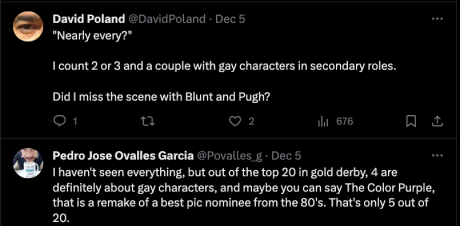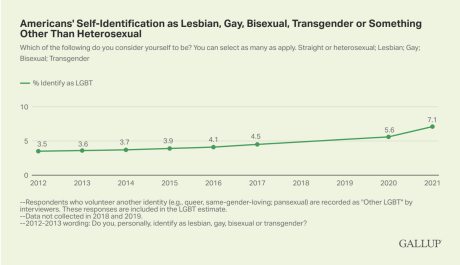Ten years ago 3.5% of Americans said they identified as LGBTQIA, and today 7.1% are so identifying — a 100% increase, mainly due to Zoomers and Younger Millennials wanting to mingle with the crowd and be trendy.
Boiled down we’re talking one out of nearly 15 people. Which means, of course, that nearly 14 out of 15 Americans identify as straight.
Do this year’s Best Picture contenders represent this approximate gay-to-straight proportion? Of course not. Do they tilt in the direction of gay-themed or gay-seasoned subject matter? No, they do not “tilt” — they lean heavily in this direction. Two-thirds to a third.
If you accept there are twelve top award contenders (and you really can’t count Napoleon among them), you’ve only got four that are completely, unregenerately, hot-dog-with-a-brewski, Travis Kelce, low-thread-count T-shirt straight with nothing the least bit gay or even gay-flirting among them — Oppenheimer, The Holdovers, Killers of the Flower Moon and Past Lives. And three of these (Oppie, Holdovers, Killers) are period pieces.
On the other hand eight of the twelve award-season contenders have gay characters or gay sex scenes, or they satirize or belittle straight males.
1. Maestro (famous gay conductor lovingly married to beard wife, with whom he’s sired three children), 2. Barbie (dozens upon dozens of might-as-well-be-gay buff-bod Kens — the only overtly straight males are played by Michael Cera and Will Ferrell and the Matell board members), 3. American Fiction (Sterling K. Brown as Jeffrey Wright‘s gay brother, Clifford Ellison), 4. Poor Things (mostly hetero but with a lesbian oral sex scene in a Paris brothel), 5. Anatomy of a Fall (Sandra Huller admits to having had same-sex affairs outside the bonds of marriage to her late husband), 6. Rustin (charismatic gay civil leader of the ’60s), 7. Nyad (lesbian long-distance swimmer) and 8. The Color Purple (partly about lesbian-tinged relationship relationship between Celie and Shug, based on a book by bisexual author Alice Walker).
Summary: On-screen this season we have eight gay or gay-tinged films vs. four that are flat-out straight. In real life nearly 14 out of 15 folks are non-LGBTQIA.
What does that tell you about where Hollywood is coming from, and to what extent that they’re making films for the vast majority of moviegoers? At least as far as the ’23 award season is concerned? I’ll tell you what it means. It means that within industry culture, it seems safer or cooler to make gayish films or those with a little gay flavoring, It neans that industry culture sees Average Joe straight culture as crude or tedious or troglodyte-ish.


 =
=
Sidenote: You can apparently buy original paperback editions of Matt Bradley‘s “Homo Hill”, a respected, relatively trim account of urban gay life during the JFK era. It first hit the stands on 1.1.63.
